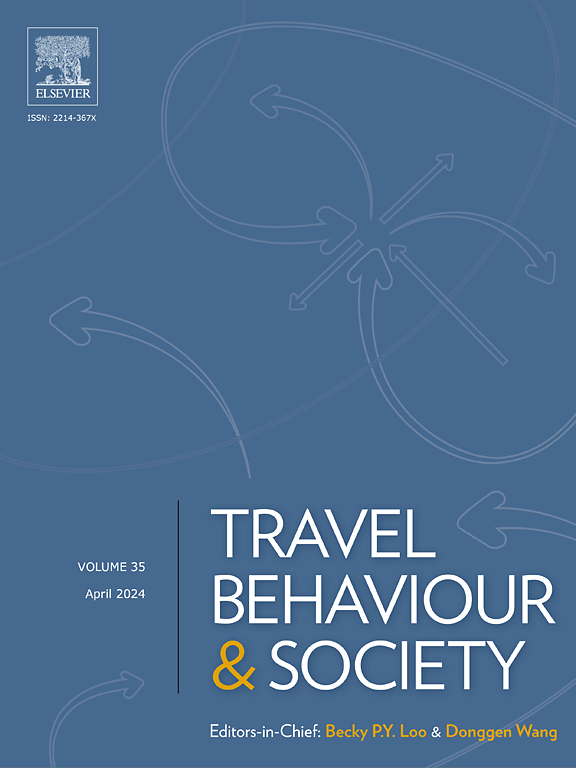量化通勤上学期间的身体活动:方法的比较
IF 5.7
2区 工程技术
Q1 TRANSPORTATION
引用次数: 0
摘要
本研究旨在用不同的方法(GPS、自我报告、固定窗口[w30和w60]和基于距离的时间)检测步行往返学校的次数,并比较旅行的开始/结束时间,以及久坐时间、轻体力活动(LPA)和中高强度体力活动(MVPA)积累的时间。共有93名西班牙青少年在上学期间佩戴加速度计和GPS,并使用五种不同的方法确定步行往返学校的开始/结束时间。使用一致性分析的混合效应极限来确定上述五种方法确定的步行旅行开始/结束时间之间的一致性水平。此外,如果与GPS的平均差异在建议的±5.0分钟的等效范围内,则确定方法是等效的。与GPS相比,自我报告的测量结果显示,与GPS相比,步行上学开始时间的估计具有良好的一致性,为0.0 (loap 95%: -0.3-0.2)小时。在测量久坐时间、LPA和MVPA方面,自我报告的测量方法被认为等同于GPS。对于LPA和MVPA, W30和基于距离的时间与GPS相同,但对于久坐时间则不同。W60仅被视为相当于GPS的步行往返学校时累积的MVPA。自我报告的测量方法显示了最精确的估计上学时间的方法,它被认为等同于GPS来量化久坐时间、LPA和MVPA。此外,根据家和学校之间的距离来估计完成旅行的时间可能比固定的窗口更合适。本文章由计算机程序翻译,如有差异,请以英文原文为准。
Quantifying physical activity during active commuting to school: A comparison of methodologies
The current study aims to detect walking trips to/from school with different methodologies (GPS, self-reported, fixed windows [w30 and w60], and distance-based time), and to compare the start/end times for the trips, and the time accumulated in sedentary time, light physical activity (LPA), and moderate-to-vigorous physical activity (MVPA). A total of 93 Spanish adolescents wore an accelerometer and GPS during school days, and the start/end times of walking trips to/from school were determined using five different methodologies. Mixed-effects limits of agreement analyses were used to determine the level of agreement between the start/end times of the walking trips identified by the five methodologies mentioned. Moreover, methodologies were determined to be equivalent if the mean difference with the GPS was within the proposed equivalence zone of ± 5.0 min. Self-reported measures showed a good level of agreement for estimating start times of walking trips to school compared to GPS, 0.0 (LoA95%:-0.3–0.2) hours. Self-reported measures were deemed equivalent to GPS for measuring sedentary time, LPA, and MVPA. W30 and distance-based time were equivalent to GPS for LPA and MVPA, but not for sedentary time. W60 was only deemed equivalent to GPS for MVPA accumulated during walking trips to and from school. Self-reported measures showed the most precise approach for estimating start times to school, as well as it deemed equivalent to GPS for quantifying sedentary time, LPA, and MVPA. Moreover, estimating the time to complete the trip based on the distance between home and school could be more appropriate than fixed windows.
求助全文
通过发布文献求助,成功后即可免费获取论文全文。
去求助
来源期刊

Travel Behaviour and Society
TRANSPORTATION-
CiteScore
9.80
自引率
7.70%
发文量
109
期刊介绍:
Travel Behaviour and Society is an interdisciplinary journal publishing high-quality original papers which report leading edge research in theories, methodologies and applications concerning transportation issues and challenges which involve the social and spatial dimensions. In particular, it provides a discussion forum for major research in travel behaviour, transportation infrastructure, transportation and environmental issues, mobility and social sustainability, transportation geographic information systems (TGIS), transportation and quality of life, transportation data collection and analysis, etc.
 求助内容:
求助内容: 应助结果提醒方式:
应助结果提醒方式:


